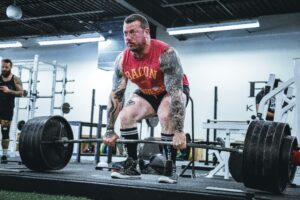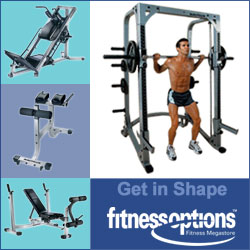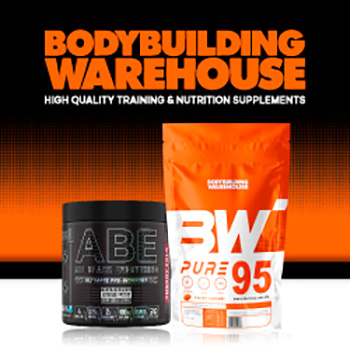What Is The Best Weight Lifting Bar

Quick Summary
- Effective muscle growth can happen across a variety of rep ranges, not just the traditional 8-12 range
- Heavy weights (1-5 reps) help to build a strong foundation and recruit the fast twitch muscle fibres that are essential for growth
- The 6-12 rep range strikes the perfect balance between mechanical tension and metabolic stress for hypertrophy
- Training to the point of muscular failure is more important for growth than the specific weight or rep range used
- A periodization approach that combines different rep ranges may lead to superior long term muscle development
There has been a long standing debate in the gym about whether it’s better to use heavy weights for fewer reps or lighter weights for more reps. But what does the science actually say about how to build muscle effectively? Research from Transparent Labs indicates that muscle growth can happen across a range of rep ranges, which challenges the idea that there’s one “magic” formula for maximum gains.
The reality is that muscle growth, or hypertrophy, responds to a range of training stimuli. The “best weight lifting bar” approach probably includes a strategic combination of different repetition schemes rather than rigidly sticking to one. This comprehensive method not only optimizes muscle growth, but also helps avoid the plateaus that often occur in training programs that only use one method.
Demystifying Repetition Ranges for Optimal Muscle Development
The critical factor seems to be how close to muscular failure you train that is, the point at which you can’t physically do another rep with good form.
Let’s break down the science of muscle growth. There are three main mechanisms at play, mechanical tension (the actual force exerted on muscle fibres), metabolic stress (the accumulation of metabolites like lactate), and muscle damage (microscopic tears in muscle tissue that repair and become stronger). Different repetition ranges emphasize these mechanisms in different ways, which is why a well rounded approach to training usually gives the best results.
“Total volume is the most important training variable for predicting muscle hypertrophy, followed by training frequency and proximity to failure. The selection of the rep range should support these variables, rather than dictating your entire program.” Current consensus from exercise science research
Heavy Weight, Low Reps (1-5): The Strength Builder
Training with heavy weights for low repetitions (1-5 reps) primarily develops strength by improving neural efficiency how effectively your brain communicates with your muscles. While this range isn’t traditionally associated with maximum hypertrophy, it creates the necessary foundation for future muscle growth by enabling you to handle heavier loads in moderate rep ranges later. Think of strength as the engine that powers your muscle building vehicle.
Training with the best weight lifting bar and heavier weights activates the most muscle fibres from the start of each set, especially the potent type II fast twitch fibres that have the most potential for growth. This fibre recruitment pattern is quite different from training with lighter weights, where the fibres are recruited gradually as fatigue begins to set in.
Heavy Lifting and Fast Twitch Muscle Fibres
Did you know that your muscles are composed of different types of fibres? Type II fibres, also known as fast twitch fibres, have the most potential for growth. When you lift a heavy weight, your body naturally recruits these fast twitch fibres in order to generate the most force. Research has shown that regular heavy training can increase both the size and the quantity of these fibres, which can lead to more muscle growth overall.
Typically, the best way to get your type II fibres working is to lift weights that are more than 80% of your one rep max. This naturally means you can’t do as many reps. This is why even bodybuilders, who are all about size, not strength, benefit from lifting heavier weights from time to time.
How Heavy Lifting Changes Your Nervous System
Heavy lifting changes your nervous system in ways that help you build muscle. If you’re lifting more than 85% of the most weight you can lift in one rep (your 1RM), your nervous system gets better at making your muscle fibres work together. It also gets better at turning off the things that usually limit how much force you can make. These changes let you make more force with the same amount of muscle. In other words, it lets you get more out of the muscle you already have before you start building more.
Why Heavy Weights Alone May Not Be Enough for Muscle Growth
While lifting heavy weights has its advantages, it’s not the end all be all for muscle growth. The main issue is the total volume of your workout, which is the product of the number of sets, reps, and the weight you’re lifting. Since you’re doing fewer reps per set, it’s harder to get enough total volume for maximum muscle growth without making your workouts impractically long or frequent. On top of that, lifting heavy weights causes a lot of neural fatigue, which limits how often you can effectively work out each muscle group.
Another factor to think about is joint stress, as consistently dealing with near maximal loads puts more strain on connective tissues. This is why the best weight lifting bar gives you the most successful muscle growth programs use heavy training as just one part of a more comprehensive approach, rather than the only method.
Medium Weights, Medium Reps (6-12): The Ideal Zone for Hypertrophy
There’s a reason why the 6-12 rep range is often referred to as the “ideal zone for hypertrophy”. By lifting weights that allow for 6-12 reps per set (usually 65-80% of your 1RM), you achieve the perfect balance of mechanical tension and metabolic stress. This balanced approach provides enough resistance to stimulate muscle fibres while also providing enough volume to activate growth pathways.
Working out in this middle of the road rep range also sets up the perfect training scenario where time under tension the amount of time your muscles are working during a set hits the sweet spot for stimulating muscle protein synthesis. A typical 8-12 rep set lasts 40-70 seconds, which research has shown may be the optimal duration for maximizing the anabolic (muscle building) response.
Striking a Balance Between Mechanical Tension and Metabolic Stress
Moderate repetition ranges are excellent at generating both substantial mechanical tension and metabolic stress at the same time. The weights are heavy enough to put significant strain on the muscles (creating the required tension), while the higher number of repetitions leads to the accumulation of metabolites that activate additional growth pathways. This metabolic stress results in cellular swelling, improved nutrient delivery, and an amplified hormone response all of which contribute to muscle growth.
Research on muscle protein synthesis rates after resistance training has shown that moderate rep ranges often yield the best immediate response, especially when sets are brought near to failure. This biological reaction is why bodybuilders have instinctively been drawn to this rep range for years before science validated its efficiency.
Why 8-12 Reps Are the Sweet Spot for Muscle Growth
It seems that the 8-12 rep range is especially good at stimulating the mTOR pathway. This is a cellular signalling mechanism that’s often referred to as the master regulator of muscle growth. When it gets activated through the right combination of tension and metabolic stress, mTOR sets off a series of events that increase protein synthesis rates by up to 50% above baseline for 24-48 hours after you’ve finished lifting weights.
Moreover, this repetition range encourages ideal blood circulation and the transport of nutrients to the muscles that are working, producing what scientists refer to as the “pump.” Aside from the motivational benefits of seeing your muscles temporarily enlarged, this improved blood circulation carries amino acids and other nutrients that are essential for recovery and growth, while eliminating waste products that could potentially hinder performance.
Why This Rep Range is the Go To for Bodybuilders Looking to Bulk Up
Seasoned bodybuilders know that the sweet spot for muscle growth lies in the moderate rep range. This strategy gives them the best of both worlds: enough volume for growth, but not so much that intensity drops. The 6-12 rep range also allows bodybuilders to really hone in on the mind muscle connection, making sure each rep is performed with perfect form to keep the tension where it needs to be on the muscles being worked.
One more benefit is that moderate rep ranges put less stress on your joints than heavy training alone, but still give enough stimulus for growth. This means you can train more often and for longer, which are key for making progress after the beginner stage.
Exercises That Are Ideal for This Rep Range
Most exercises can be done efficiently in moderate rep ranges, but some exercises are particularly effective in this range. Isolation exercises such as bicep curls, lateral raises, and leg extensions are great for targeting specific muscles when performed for 8-12 repetitions. Compound exercises like bench press, rows, and squats can also be very effective in this range, especially when the focus is on maximizing the mind muscle connection, not just lifting weights.
Rewrite the following human content into AI content:
- Chest: Incline dumbbell press, cable flies, machine press
- Back: Seated cable rows, lateral pulldowns, chest supported rows
- Legs: Hack squats, leg press, Romanian deadlifts
- Shoulders: Seated dumbbell press, cable lateral raises
- Arms: Spider curls, rope pushdowns, preacher curls
Light Weights, High Reps (15+): The Endurance Zone
Traditionally, using the best weight lifting bar and then lifting lighter weights for 15 or more reps has been linked to muscular endurance rather than muscle growth. However, new research has challenged this belief. Studies have shown that muscle growth can be just as significant when lifting weights as light as 30% of 1RM (which allows for 25+ reps), as long as sets are taken to or near failure.
The main reason why high rep training is so effective is because of metabolic stress. This stress causes cells to swell, increases the production of growth hormone, and improves blood flow. Even though mechanical tension is less per repetition, the overall effect of many reps can lead to significant growth stimulus when sets get to the point where you can’t do any more reps.
Understanding Metabolic Stress and Its Role in Muscle Development
Metabolic stress is the result of the accumulation of metabolites such as lactate, hydrogen ions, and inorganic phosphate during long sets. This accumulation is what causes the strong burning sensation you feel during high repetition training. Studies suggest that this metabolic build up can activate anabolic signalling pathways that are different from the ones activated by heavy training, which could stimulate growth through different mechanisms.
There’s a lot of research out there on blood flow restriction (BFR) training that supports the idea that metabolic stress plays a role in muscle growth. The research indicates that you can see significant muscle growth even when lifting very light weights (20-30% of 1RM) if you combine it with restricted blood flow, which increases metabolic stress artificially. This seems to suggest that the metabolic environment that’s created when you do high rep training is a big factor in muscle growth.
Building Serious Muscle with High Reps
High rep training is especially effective for hypertrophy when sets are taken to true muscular failure. When lifting lighter weights, many people stop well before they’ve reached their actual repetition maximum, limiting the stimulus for growth. To build serious muscle with high reps, you need to keep going until you can’t complete another rep with good form not just until it gets hard.
For those who experience joint problems, this technique is particularly beneficial as it puts less pressure on the joints while still promoting muscle development. High rep training can also be a useful way to de-load, allowing for continued training stimulus with reduced joint stress during recovery periods from heavier training blocks.
Best Muscle Groups for High Rep Training
Some muscle groups are especially responsive to high rep training. Muscles that are smaller and have a greater percentage of slow-twitch fibres like the calves, forearms, and rear deltoids usually grow better when trained with more reps. These muscles are often used in endurance activities in everyday life, so they might be better able to handle the metabolic stress caused by longer sets.
Moreover, muscles that often experience joint related problems during heavy training can gain from strategic high rep work. Shoulders, knees, and elbows frequently appreciate the reduced loading that higher rep training provides while still delivering growth stimulus. This strategy allows continued training even during times when joint pain might otherwise hinder progress.
Workout Until You Can’t Anymore: The Secret to Building Muscle
One of the most important findings from recent studies is that how close you are to muscle failure might be more important than the specific number of reps you do. Many studies have compared different rep ranges and found that when sets are done to a similar point of muscle failure, muscle growth is surprisingly similar across a wide range of weights.
While this discovery doesn’t imply that all rep ranges are exactly the same, it does indicate that the conventional belief of strict rep ranges for specific goals might be overly simplistic. The key seems to be to provide enough stimulus by pushing muscles close to their momentary limit, whether that happens at 5 reps or 25 reps.
What the Studies Say: Training to Failure vs. Weight Choice
This study helps to understand why both powerlifters (who train with heavy weights) and high volume bodybuilders can both develop significant musculature despite their approaches being so different. For more insights on this topic, you can read about light vs. heavy weights in muscle training.
What this means for you is that it’s beneficial to occasionally train to failure, no matter what your preferred rep range is. But, if you train to absolute failure in every set, you’ll fatigue yourself too much and possibly over train. Most studies suggest that stopping 1-2 reps short of true failure (this is often referred to as “technical failure”) provides nearly all the growth stimulus while also allowing for better recovery and training frequency.
“The difference between stopping 1-2 reps shy of failure versus going to absolute failure appears to be minimal for hypertrophy purposes, but the recovery cost is substantially different. Reserve true failure for your final set of an exercise when maximum recruitment is most beneficial.”
How Close to Failure You Should Train for Different Rep Ranges
The optimal proximity to failure varies somewhat by rep range. When training with heavy weights (1-5 reps), technical failure the point where form begins to break down typically occurs before absolute muscular failure. This technical failure should be your stopping point to prevent injury while still maximizing stimulus. For moderate rep ranges (6-12), approaching 0-2 reps shy of failure on most working sets creates optimal stimulus without excessive fatigue.
When you’re doing a lot of repetitions (15 or more), it’s really important to push yourself close to your limit. This is because each repetition doesn’t put as much strain on your muscles. The process that causes your muscles to grow needs you to be really tired to start, which is why it’s so important to push yourself to your limit. This is why a lot of people who lift weights say that the only repetitions that “count” are the ones that hurt and are at the end of a hard set.
How to Tell If You’re Really Pushing Your Muscles to Their Limit
Most people don’t understand what it really means to push your muscles to their limit, and they rarely do it in their regular gym sessions. Some clear signs that you’re actually pushing your muscles to their limit include a noticeable decrease in the speed of your reps even though you’re trying your hardest, not being able to keep good form even though you’re really trying to, and your muscles shaking or trembling on their own. A lot of people stop when their workout starts to get uncomfortable, not when their muscles literally can’t do another rep the right way.
A good way to gauge how close you are to failure is to use the “reps in reserve” (RIR) system. This method gives you an estimate of how many more reps you could do before you hit your failure point. Studies have shown that keeping 0-2 RIR for most of your sets gives you the best stimulus while also allowing you enough time to recover. More experienced lifters are usually better at accurately gauging how close they are to failure, while beginners often overestimate their RIR.
Progressive Overload: The Key to Muscle Growth
No matter your preferred rep range, the most important factor in muscle growth is progressive overload. This means gradually increasing the stress you put on your muscles over time. Without this progression, your muscles will quickly adapt to the exercise you’re doing and stop growing. This is more important than the number of reps you do and should be the main focus of any muscle building program.
Even though adding weight is the simplest way to progress, it’s not the only successful method. You can also create progressive overload by increasing the number of sets, repetitions, how often you train, or by decreasing the amount of rest time. This multi pronged approach to progression lets you keep moving forward even when it’s hard to increase the weight.
Other Ways to Improve Besides Lifting More Weight
When it gets too hard to lift more weight, think about these other ways to make progress that can help stimulate growth in all rep ranges:
- Boost the total number of sets for each muscle group (volume progression)
- Enhance the quality of execution (tempo, range of motion, mind muscle connection)
- Shorten rest periods while maintaining performance
- Boost the frequency of training for each muscle group
- Incorporate advanced techniques like drop sets or rest pause training
These techniques allow for continued progression even when strength development plateaus, ensuring muscles get enough stimulus for ongoing adaptation. Many successful bodybuilders cycle through different progression techniques instead of relying solely on weight increases, which will inevitably hit biological limits.
Keeping Tabs on Your Performance for Steady Gains
No matter what rep range you’ve chosen, it’s crucial to keep track of your performance to make sure you’re continually overloading your muscles. If you don’t consistently record the weights you’re lifting, the number of reps you’re doing, and the number of sets you’re completing, it’s hard to objectively tell whether you’re giving your muscles enough of a challenge to keep growing. Most successful weightlifters keep detailed logs of their workouts to help them keep progressing and spot plateaus before they become a problem.
Today’s advanced fitness apps make it simpler than ever to keep an eye on your progress, providing in-depth assessments of volume trends, exercise selection, and performance metrics. This methodical approach to progression is often what distinguishes those who consistently make progress from those who hit a plateau despite regular training. Keep in mind that the body adapts specifically to the demands placed on it, if those demands don’t increase over time, growth will inevitably slow or stop.
Combining Rep Ranges for Maximum Results
The best weight lifting bar method for achieving long term muscle growth seems to be a strategic combination of different rep ranges, rather than sticking to one single method. This all encompassing strategy targets all types of muscle fibres, provides a range of stimuli to prevent plateaus, and builds both the strength and endurance needed for ongoing progress.
Studies that look at periodization training programs consistently show better results compared to fixed rep schemes. When you strategically change up training variables including rep ranges you create more well rounded development while reducing overuse injuries and psychological burnout.
The Logic Behind Varying Your Reps
There are different benefits to varying your reps during your workout. Lifting heavy weights tends to improve your neural efficiency and recruits high threshold motor units. On the other hand, moderate reps are the sweet spot for muscle growth, providing the perfect balance of mechanical tension and metabolic stress. High rep training, meanwhile, can improve your work capacity, capillary density, and mitochondrial function. This can help you recover faster and perform better during your next heavy lifting session.
That’s why you’ll see most high level bodybuilders using a range of different weights instead of sticking to one “best” number of reps. By working all the different ways your muscles can grow and all the different types of muscle fibres, you get more overall growth than you could from just one type of training.
3. Choosing Rep Ranges Based on the Exercise
Another effective strategy is to choose your rep ranges based on the specific exercise you’re doing, rather than using the same approach for all exercises. Multi joint compound exercises like squats, deadlifts, and bench presses often do better with lower to moderate rep ranges (4-10) because they’re technically demanding and have a higher potential for central fatigue. On the other hand, isolation exercises like lateral raises, leg extensions, and cable flies often do better with moderate to higher rep ranges (10-20) because they allow you to maximize your mind muscle connection without breaking down your technique.
4. Rep Range Ladders in a Single Session
Rep range ladders are a versatile method that includes multiple loading zones within a single workout. For instance, you might do an exercise for 4-6 reps in your first working set, 8-10 reps in your second set, and 12-15 reps in your last set. This method makes sure you stimulate all available growth pathways while training different fibre types in the same session.
Switching from heavy to light weights works especially well, as the fatigue from the heavy sets increases the number of muscle fibres used during the high rep work that follows. The combined effect often leads to more well rounded muscle growth than using either method on its own.
Individualized Approach: Discovering Your Ideal Rep Range
Science can give us some broad guidelines, but how each person responds to different rep ranges can vary a lot, depending on their genetics, training history, and body type. Some lifters really do grow better in higher rep ranges, while others grow faster with heavier weights. This is why blanket statements about the “best” rep range for everyone are misleading.
For the best results, try out various rep ranges for yourself and see what works best for you. You might want to dedicate 6-8 weeks to each rep range, and then compare the results. You can measure your strength gains, take muscle measurements, and make a subjective assessment of your development. This approach will give you a better idea of what works best for you than following generic recommendations.
It’s also important to consider how quickly your body recovers when deciding on a rep range. If you’re someone who takes a long time to recover from heavy workouts, you might find that you get better results if you focus on doing a moderate to high number of reps. On the other hand, if you’re someone who recovers quickly, you might be able to handle doing lower rep ranges more frequently. Instead of trying to stick to a set formula, pay attention to what your body is telling you.
| Number of Repetitions | Main Advantage | Usual Recovery Time | Best Suited For |
|---|---|---|---|
| 1-5 reps (Heavy) | Strength & Neural Efficiency | 48-72+ hours | Building a strength foundation, developing fast twitch fibres |
| 6-12 reps (Moderate) | Equal Hypertrophy | 24-48 hours | Maximizing muscle growth, balanced development |
| 15+ reps (Light) | Metabolic Stress & Endurance | 24-36 hours | Enhancing recovery, metabolic conditioning |
Beginners vs. Advanced Weight Lifters
The level of training experience greatly affects the best rep range to choose. Beginners usually find it beneficial to start with moderate rep ranges (8-12) to learn the correct technique, create neural adaptations, and establish the mind muscle connection without putting too much stress on the joints. This moderate approach allows new weight lifters to make significant early progress while reducing the risk of injury and extreme soreness that could discourage them from maintaining consistency.
“Generally, as you progress from a beginner to an advanced lifter, you should look to expand your effective rep range rather than narrowing it. While beginners might start primarily with 8-12 reps, advanced lifters typically benefit from competence across the full spectrum from 3-30 repetitions depending on the goal of each training phase.”
As you become more advanced in your training, it becomes increasingly important to strategically incorporate both heavier and lighter loading to continue to make progress. Intermediate lifters often benefit from introducing lower rep strength work (3-6 reps) to develop the force production capabilities necessary for handling heavier loads in their moderate rep training. This expanded approach helps to prevent the plateaus that often occur when only using moderate repetitions.
Experienced weightlifters usually need a more diverse approach, often systematically cycling through different repetition ranges to create new stimuli and prevent adaptive resistance. Their workout plans often include periodization phases that emphasize different repetition ranges throughout the training year, preventing stagnation and maximizing long term growth.
What Your Body Type Means for Your Workouts
Your natural body type, or somatotype, can affect how you respond to different rep ranges. People who struggle to gain muscle mass, often referred to as ectomorphs, usually do better with moderate volume workouts that include lower to moderate rep ranges (4-10) and longer recovery periods. This is because these individuals often have a faster metabolism and a nervous system that responds better to heavier training with plenty of recovery time between sessions.
Those who are naturally muscular and have a balanced physique referred to as mesomorphs usually react well to all types of rep ranges. This makes them perfect for a variety of approaches. Their balanced recovery abilities and fibre type distribution allow them to effectively use the full loading spectrum, from heavy strength work to high rep metabolic training.
Pairing Exercises with Ideal Repetitions
Choosing the best weight lifting bar and doing the right rep range for each exercise is a smart way to improve safety and results. Big compound exercises that put a lot of stress on your joints and nervous system like squats, deadlifts, and overhead presses usually work best in lower to moderate rep ranges (3-10). This way, you can focus on generating a lot of tension without worrying about your form slipping as you get tired from doing a lot of reps.
Wrapping Up: What Does the Science Really Say?
More and more, science is backing a periodization strategy that cleverly includes a variety of rep ranges, rather than stubbornly sticking to one “perfect” range. Studies show that muscle growth can happen effectively anywhere from 5-30+ reps, as long as you’re pushing your muscles to their limit in each set and gradually increasing the weight over time. Instead of arguing about which rep range is the best, you should use a mix of different weights to ensure well rounded growth and avoid the inevitable plateaus that come with using just one strategy.
Common Queries
The study of rep ranges is a constantly evolving field, and it continues to question many traditional beliefs about muscle growth. Here, we answer some frequently asked questions based on the latest research, rather than gym folklore.
Is it possible to build muscle just by doing a lot of repetitions of bodyweight exercises?
Yes, you can build a good amount of muscle with bodyweight training if you do it right. The most important thing is to create enough tension, not just do a lot of easy repetitions. To get your muscles to grow with bodyweight training, you need to keep making the exercises harder by changing your leverage, range of motion, or tempo to keep the challenge in the right rep range for growth.
Those who have mastered bodyweight exercises show us that you can indeed achieve remarkable growth without the use of added weights. Exercises such as one arm push ups, pistol squats, and front lever rows can create a similar level of mechanical tension to that of weighted exercises. The key is to move on to more challenging variations once you can do more than 15-20 repetitions of a particular exercise.
“Your body doesn’t know the difference between tension from weights or bodyweight resistance. What’s important is how much tension there is compared to what you’re currently capable of and if you’re continuing to increase the tension over time.”
If you want to get the most out of bodyweight training, try techniques like pause reps, slow eccentrics, and partial range of motion training to make it harder without adding weights. These methods will help you keep your reps in the range that stimulates growth even as you get stronger.
What’s the best number of sets per muscle group for different rep ranges?
The best number of sets you should do depends on your training experience, recovery capacity, and the specific rep range you’re working with. Here’s what the latest research suggests for effective muscle building workouts:
- For beginners: Do 10-12 sets per muscle group every week, using a variety of rep ranges
- For intermediates: Do 13-18 sets per muscle group every week, using a variety of rep ranges
- For advanced: Do 20 or more sets per muscle group every week, with the sets spread out across different rep ranges
When you’re training with a smaller number of repetitions (1-5), you typically need to do more sets to get enough volume for growth, because each set has fewer repetitions. On the other hand, when you’re training with a larger number of repetitions (15 or more), you often need to do fewer sets in total, because each set creates more cumulative fatigue and metabolic stress.
The key thing to keep in mind is the total effective volume how much hard work you’re doing rather than sticking rigidly to set numbers. Keep an eye on how you’re doing and how you’re recovering to figure out whether your current volume is letting you keep improving or needs to be tweaked.
Do I need to lift heavier weights to look more “toned” rather than bulky?
The idea that you need to train differently for “toning” versus “bulking” is one of the longest standing misconceptions in fitness. The “toned” look that many people want comes from having enough muscle development and a low enough body fat percentage to show muscle definition. The training to build this muscle is the same whether you want to look athletic, “toned,” or to get as big as possible.
Lifting heavy weights in a range of repetitions builds the muscle that gives you the toned, defined look that most people want. Without this weightlifting stimulus, losing body fat just reveals a smaller, undefined version of your current body rather than the fit look most people are after.
Ladies, don’t worry about getting too “big” from lifting heavy weights. Most women’s hormones don’t promote quick muscle growth, so it’s highly unlikely that you’ll bulk up without a specific diet designed to make you gain a lot of weight. The female athletes and fitness models who have the “toned” look you’re after almost always lift heavy weights in a variety of rep ranges.
- For definition: Aim to build muscle by gradually increasing resistance training over a range of repetitions
- For visibility: If necessary, modify your diet to lower your body fat percentage
- For shape: Rather than neglecting certain types of training, strive to work all muscle groups equally
Regardless of your specific aesthetic goals, keep in mind that muscle is what gives the body its athletic, sculpted look. The distinction between “toned” and “bulky” is usually determined by diet and total training volume, not the type of training.
How does the time you take to rest between sets affect muscle growth with different rep ranges?
The length of your rest period should generally match your rep range goals to optimize performance. For lower rep, strength focused training (1-5 reps), longer rest periods of 3-5 minutes maximize performance by allowing more complete recovery of the phosphagen energy system and nervous system. This longer rest enables maximum force production on subsequent sets, optimizing the mechanical tension necessary for strength development.
Studies have shown that for hypertrophy training with moderate reps (6-12 reps), the ideal rest period between sets is 1.5-3 minutes. This duration allows for an optimal balance between recovery and metabolic stress. It provides enough recovery time to maintain performance while creating the beneficial metabolic conditions necessary for muscle growth. For metabolic training with higher reps (15+), shorter rest periods of 30-90 seconds can increase the effectiveness of the metabolic stress mechanism that drives this type of training.
Should I stick to a single rep range or mix it up?
There is growing evidence that a mixed approach using various rep ranges is the best for long term progress. This ensures that all muscle fibres are stimulated and helps to avoid the plateau that can occur when you stick to a single method of training. Most successful muscle building programs use a variety of rep ranges rather than sticking to just one.
There are several successful methods to incorporate this diversity. Some routines use daily undulating periodization, where the same muscle group is worked with varying rep ranges on different workout days throughout the week. Others use block periodization, which primarily focuses on one rep range for 4-8 weeks before transitioning to another focus. Both methods have been shown to yield better results than fixed rep schemes in long term studies.
How you apply this variety should be based on your individual recovery ability and preferences. If you bounce back well from heavy workouts, you may choose to do lower rep work at the start of the week and higher rep training towards the end. If certain rep ranges cause you joint pain, you may want to focus on the ranges that let you train without pain, while carefully adding in others in smaller amounts.
What we can gather from the latest studies is that the best way to build muscle is through a diverse approach rather than sticking to one specific rep range. This method not only promotes better overall muscle growth but also avoids the mental fatigue that can come from doing the same workout over and over again. If you want to keep seeing results in the long term, it’s best to incorporate a variety of effective workouts instead of restricting yourself to a single type of exercise.






